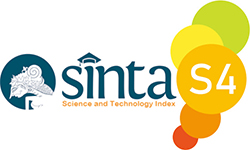EXPLORING EMPLOYEE SATISFACTION IN AICE GROUP INDONESIA
Abstract
Abstract: AICE Group is a licensed company from Singapore and has 20 years of experience in the ice cream industry. Fundamentally, employees are the most important asset to develop the competitive advantage of a company. Thus, AICE Group needs to retain and motivate its current employees. In this qualitative study, the researchers inquired into the issues and strategies of employee satisfaction in the company by employing a single instrumental case study and applying interviews, observations, and field notes. There are 8 employees from 5 departments who were approached for this study. The findings evinced a mini-model theory that guides AICE in Indonesia to enhance employee satisfaction for the longevity of the firm. The mini-model theory consists of Communicative Leadership, Language Barrier, Supervision, AICE Group Culture, Co-Workers’ Relationships, Rational Salaries, Rational Benefit, Job Descriptions, Standard Operating Procedure (SOP), Problem-Solving Orientation, Cultural Diversity, Government Regulation Compliance, and Employee Feedback. Finally, the researcher also suggests quantitative research for further research.
Abstrak: AICE Group adalah perusahaan berlisensi dari Singapura dan memiliki pengalaman 20 tahun di industri es krim. Pada dasarnya, karyawan merupakan aset terpenting untuk mengembangkan keunggulan kompetitif suatu perusahaan. Oleh karena itu, AICE Group perlu mempertahankan dan memotivasi karyawannya saat ini. Dalam studi kualitatif ini, para peneliti menyelidiki masalah dan strategi kepuasan karyawan di perusahaan dengan menggunakan studi kasus instrumental tunggal dan menerapkan wawancara, observasi, dan catatan lapangan. Ada 8 karyawan dari 5 departemen yang didekati untuk penelitian ini. Temuan ini membuktikan teori model mini yang memandu AICE di Indonesia untuk meningkatkan kepuasan karyawan demi kelangsungan perusahaan. Teori model mini terdiri dari Communicative Leadership, Language Barrier, Supervision, AICE Group Culture, Co-Workers’ Relationships, Rational Salaries, Rational Benefits, Job Descriptions, Standard Operating Procedure, Problem-Solving Orientation, Cultural Diversity, Government Regulations Compliance, and Employee Feedback. Terakhir, peneliti juga menyarankan penelitian kuantitatif untuk penelitian selanjutnya.
Full Text:
PDFReferences
Amabile, T. M., Schatzel, E. A., Moneta, G. B., & Kramer, S. J. (2004). Leader behaviors and the work environment for creativity: Perceived leader support. The Leadership Quarterly, 15(1), 5-32.
Appel-Meulenbroek, R., Kemperman, A. D. A. M., van Susante, P., & Hoendervanger, J. G. (2015). Differences in employee satisfaction in new versus traditional work environments. EuroFM Research Papers Advancing knowledge in FM. People Make Facilities Management, 202-209.
Askew, S., & Lodge, C. (2004). Gifts, ping-pong and loops–linking feedback and learning. In Feedback for learning (pp. 13-30). Routledge.
Chaudhry, M. S., Sabir, H. M., Rafi, N., & Kalyar, M. N. (2011). Exploring the relationship between salary satisfaction and job satisfaction: A comparison of public and private sector organizations. The Journal of Commerce, 3(4), 1.
Creswell, J. W., & Poth, C. N. (2016). Qualitative inquiry and research design: Choosing among five approaches. Sage publications.
Eisenhardt, K. M. (1989). Building theories from case study research. Academy of management review, 14(4), 532-550.
Feldman, D. C. (1985). Managing individual and group behavior in organizations. McGraw-Hill Book Co.
Henki, I.L and Zahrida, W. (2014). Pengantar Manajemen Edisi 2. Jakarta: In Media
Jobstreet Indonesia (2017). Accessed March 21, 2021. www.jobstreet.co.id.
Johansson, C., Miller, V. D., & Hamrin, S. (2014). Conceptualizing communicative leadership: A framework for analysing and developing leaders’ communication competence. Corporate Communications: An International Journal.
Jovane, F., Yoshikawa, H., Alting, L., Boer, C. R., Westkamper, E., Williams, D., & Paci, A. M. (2008). The incoming global technological and industrial revolution towards competitive sustainable manufacturing. CIRP annals, 57(2), 641-659.
Karamoy, H., & Tulung, J. E. (2020). The Effect of Banking Risk on Indonesian Regional Development Bank. Banks and Bank Systems, 15(2), 130-137
Karamoy, H., & Tulung, J. E. (2020). The Effect of Financial Performance and Corporate Governance to Stock Price in Non-Bank Financial Industry. Corporate Ownership & Control, 17(2), 97-103.
Matthews, J., Stanley, T., & Davidson, P. (2018). Human factors and project challenges influencing employee engagement in a project-based organisation (PBO). International Journal of Managing Projects in Business.
Miles, M. B., & Huberman, A. M.(1994). Qualitative data analysis: An expanded sourcebook. Sage.
Miltenburg, J. (2008). Setting manufacturing strategy for a factory-within-a- factory. International Journal of Production Economics, 113(1), 307-323.
Moldavska, A., & Welo, T. (2017). The concept of sustainable manufacturing and its definitions: A content-analysis based literature review. Journal of Cleaner Production, 166, 744-755.
Nawose Ing’ollan, D., & Roussel, J. (2017). Influence of leadership styles on employees’ performance: A study of Turkana County, Kenya. International Journal of Business and Social Science, 8(7), 82-98.
Ng, H. C., Tan, J. D., Sugiarto, S., Widjaja, A. W., & Pramono, R. (2021). Too Big to Fail: Succession Challenge in Large Family Businesses. The Journal of Asian Finance, Economics, and Business, 8(1), 199-206.
Robbins, S.P. Odendaal, A., &Roodt, G. (2003), “Organisational Behaviour”, (9th ed.). Cape Town: Prentice-Hall International.
Saari, L. M., & Judge, T. A. (2004). Employee attitudes and job satisfaction. Human Resource Management: Published in Cooperation with the School of Business Administration, The University of Michigan and in alliance with the Society of Human Resources Management, 43(4), 395-407.
Saldaña, J. (2021). The coding manual for qualitative researchers. sage.
DOI: https://doi.org/10.35794/jmbi.v8i2.34990
Refbacks
- There are currently no refbacks.

This work is licensed under a Creative Commons Attribution-NonCommercial-ShareAlike 4.0 International License.







